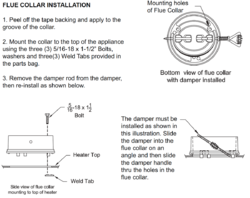We have an old wood stove from the 60's that I have been working with to try to increase the heat output on. last year we installed a full chimney liner top to bottom and sealed the top and bottom of the chimney to eliminate losing so much warm air.
This stove has intake dampers but no flue damper, i was told if we install one of those pipe flue dampers it will help slow down the rate wood we go through and will give off more heat.
Although we replaced the gaskets last year the stove still seems to be very leaky and with both intake dampers closed we still have a nice fire going.
I can see how a flue damper would slow down how fast the wood burns, but how would it increase the heat output?
This stove has intake dampers but no flue damper, i was told if we install one of those pipe flue dampers it will help slow down the rate wood we go through and will give off more heat.
Although we replaced the gaskets last year the stove still seems to be very leaky and with both intake dampers closed we still have a nice fire going.
I can see how a flue damper would slow down how fast the wood burns, but how would it increase the heat output?


